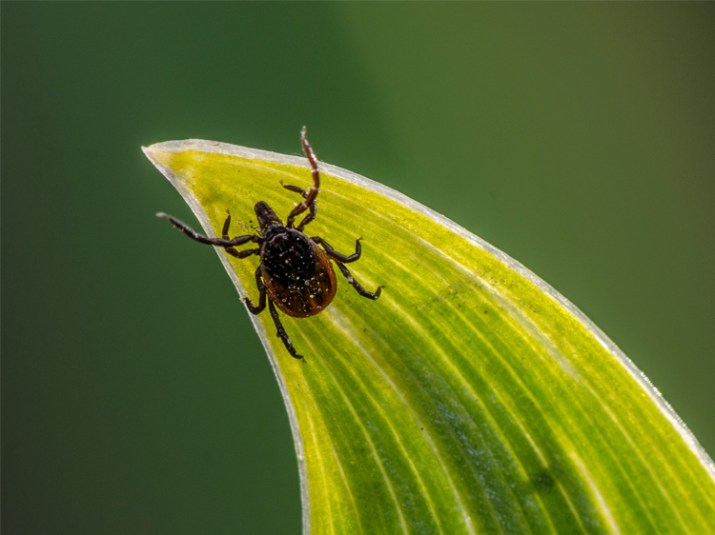Spraying Your Clothes With a Chrysanthemum-Like Pesticide Effectively Repels Ticks, CDC Says

If ticks are bugging you this season, new research may have the perfect solution to keeping those pests away. The best part? It’s some age-old advice that’s finally getting new scientific recognition.
The tick prevention trick involves spraying your clothing with permethrin, which is a pesticide that is chemically similar to the chrysanthemum plant. In a May 2018 study published in the Journal of Medical Entomology, researchers at the Centers for Disease Control and Prevention (CDC) tested 10 types of permethrin-treated clothing by letting different species of ticks loose on the tick-unfriendly material.
“We wanted to see how long [the ticks would] have to be in contact with the clothing to be incapacitated and die,” said lead author Lars Eisen, PhD, in an interview with NPR.
As it turned out, the ticks became irritated very quickly after coming in contact with the permethrin. “They essentially start flipping backwards and start rolling off the treated clothing,” Dr. Eisen said.
Even if the ticks didn’t die as a result, they were no longer able to bite afterward.
This is especially good news you can use considering the fact that the number of people getting diseases from mosquito, tick, and flea bites has more than tripled in the United States in recent years, according to the Centers for Disease Control and Prevention. Since 2004, nine new germs spread by mosquitoes and ticks have been discovered or introduced in our country. Federal health officials say warmer weather is one cause of the surge, but increased jet travel and lack of vaccines also play a role. The only good news is that there are several ways to protect yourself.
The CDC recommends that everyone use an Environmental Protection Agency-registered insect repellent, wear long-sleeved shirts and long pants whenever possible, and treat items such as boots and pants with permethrin. Of course, they also suggest taking steps to control these bugs inside and outside of the home as well. Ideally, you should try to avoid as many of these pests as possible. But how can you avoid ticks in particular when it seems like they’re everywhere these days? We reached out to insiders to get tips and tricks for how to stay safe this spring and summer — and what to do when your health is at risk.
What does a tick look like?
In order to raise awareness of tick season, the CDC took to Twitter to challenge people to spot five ticks hiding in a photo of a seemingly harmless muffin. As the agency explained in the photo caption, “Ticks can be the size of a poppy seed.” Considering the CDC specifically used a poppy seed muffin, it’s a little tougher to find the bugs than you might think. Luckily, the agency also included a helpful close-up shot of the muffin, zooming in on the exact place where those little stinkers were hiding.
Ticks can be the size of a poppy seed. Can you spot all 5 ticks in this photo? Learn how to prevent tick bites. https://t.co/ATtrY7YFoS pic.twitter.com/gBm4tw2qmf
— CDC (@CDCgov) May 4, 2018
If you had trouble finding them in the original image, be sure you take a good, hard look at the detailed shot in the close-up. Juxtaposed on that poor muffin, these ticks won’t be easy to forget!
Where do people encounter ticks?
“Ticks are generally found outdoors, but not only in the great outdoors,” explained Rebeccah Shalev, a naturopathic doctor who specializes in treating Lyme disease with the Holtorf Medical Group in Foster City, California. “When out hiking, avoid wooded and brushy areas, as well as areas with tall grasses and accumulations of leaves on the ground. Staying to the center of trails can reduce the chance of having a tick jump onto you from the edge of the trail. But all these conditions can also exist at home, right in your backyard.”
Want to keep your backyard tick-free? “Keep your lawn mowed, remove piles of trash or old mattresses where ticks can hide, and consider fencing the perimeter of your yard,” said Dr. Shalev. “This can reduce the chance of deer or stray dogs wandering in and carrying ticks with them. If your yard abuts a wooded or overgrown grassy area, leave a three-foot wide buffer strip of wood chips or gravel between your yard and the tick haven next door.”
How can you prevent tick bites?
“Avoiding areas where ticks are found is one strategy,” said Patricia Salber, MD, founder of The Doctor Weighs In. “But that would mean missing out spending time in some very beautiful places.”
So instead, make sure you dress to protect yourself. “If you are planning a hike in the woods or a stroll through tick-infested grassy areas, dress in long-sleeved shirts and long pants,” said Dr. Salber. “Tuck your pant legs into your socks so you block the tick’s ability to reach your skin, and wear a hat.” Dr. Shalev also recommends spraying your clothing with insect repellent to be extra safe.
But it’s not just about keeping your skin hidden away. It’s also about protecting it. Use a tick repellent that contains DEET on all of your exposed skin — you can check out the Center for Disease Control’s recommendations on their website — to keep it all safe. If you hate the odor of DEET, Dr. Shalev suggests using repellents with essential oils, although these may be less effective than chemical repellents.
“Plants in the wild have to defend themselves from attacks by insects and microbes that exist in their environment, and they produce essential oils for their own protection,” she said. “Some essential oils that have been shown to be particularly effective against ticks are lemon, eucalyptus, geranium, and lavender.”
When you’re ready to come inside, throw all your clothing directly into the wash on hot or go straight to the dryer. The high temps will take care of any ticks that still managed to find their way inside.
How do you know if you’ve been bitten?
The truth is, you might not know — according to Dr. Shalev, ticks “secrete a small amount of anesthetic into their saliva to keep you from feeling the bite.” So when you get home, perform a visual tick check. You can do this with a buddy or by looking in the mirror, but it’s important to be thorough.
“Pay special attention to the scalp, underarms, groin, backs of knees, belly button and inside and behind the ears,” says Dr. Shalev.
It’s also important to check your hair. And don’t forget to check any furry friends you brought outdoors. “If your dog went with you on the hike, he deserves a thorough tick check as well,” says Dr. Salber.
How can you remove a tick?
Dr. Salber has the answer: “There are many ‘old wives’ tales’ about how to remove a tick, but experts recommend only one: grab the base of the tick near the embedded mouth parts, preferably with fine tweezers. Then gently pull it outward from the skin with a slow steady pull so that you don’t break off the mouth parts and leave them in the skin. If the mouth parts do break off, leave them alone. The body will expel them on their own. Do not try to dig them out as you will traumatize the skin and you can cause a skin infection.”
Dr. Shalev also recommends the Tick Twister, which you can buy on Amazon.
Is there anything else you need to do if you’ve been bitten?
Clean the bite area and your hands with soap and water. If you have an iodine swab or alcohol, those can be used to clean the bite area as well, says Dr. Shalev. “Applying a topical antibiotic and a Band-Aid to the bite is also not a bad idea.”
If you’re in an area where Lyme disease or other tick-borne diseases are a risk, you’ll want to save the tick for testing. “Wrap the tick in tissue and put it in a container that you can close tightly. Keep it in a cool place,” Dr. Salber instructs. “It is also helpful if you can provide information to your clinician about the size and color of the tick when alive (take pictures with your smartphone) and whether it was actually attached to the skin, if it was engorged (full of blood), and how long it was attached.”
How will you know if you get sick?
If you see signs of infection — Dr. Salber says to watch out for redness, swelling, pain and warm skin — you might have a bacterial skin infection from the bite, which can be treated with antibiotics from your doctor.
As if a bug bite weren’t bad enough on its own, one specific tick bite can cause people to develop a meat allergy, experts are saying. That’s right, if you’re bitten by a Lone Star tick — a notorious pest found mostly in woodlands with dense undergrowth in the South, Midwest, and Northeast of the United States — you may have to give up your beloved burgers.
This meat allergy, also known as the alpha-gal allergy, was first identified about 10 years ago, but there were only a few dozen cases back then. In just a decade’s time, the allergy has increased exponentially. “We’re confident that the number is over 5,000 [cases], and that’s in the US alone,” said allergist Scott Commins, PhD, in an interview with NPR. Experts still aren’t sure exactly how these ticks cause the apha-gal allergy, but what they do know is that alpha gal is a sugar in many animals’ bodies that humans do not make. So it’s possible that these Lone Star ticks are simply injecting humans with that sugar through their nasty bites.
If you think you might be at risk for a tick-borne disease, Dr. Shalev advices that you seek treatment right away. “The safest course of action is to freeze the tick in case you want to test it in the future, but begin prophylactic antibiotic therapy right away, whether you develop a bull’s-eye rash or not.”
More From FIRST
How to Protect Your Home During Stink Bug Season
Knowing What a Bed Bug Looks Like Will Prevent a Future Freak Out
Woman Trying to Kill Bug Only to Burn Down Apartment Is All of Us













